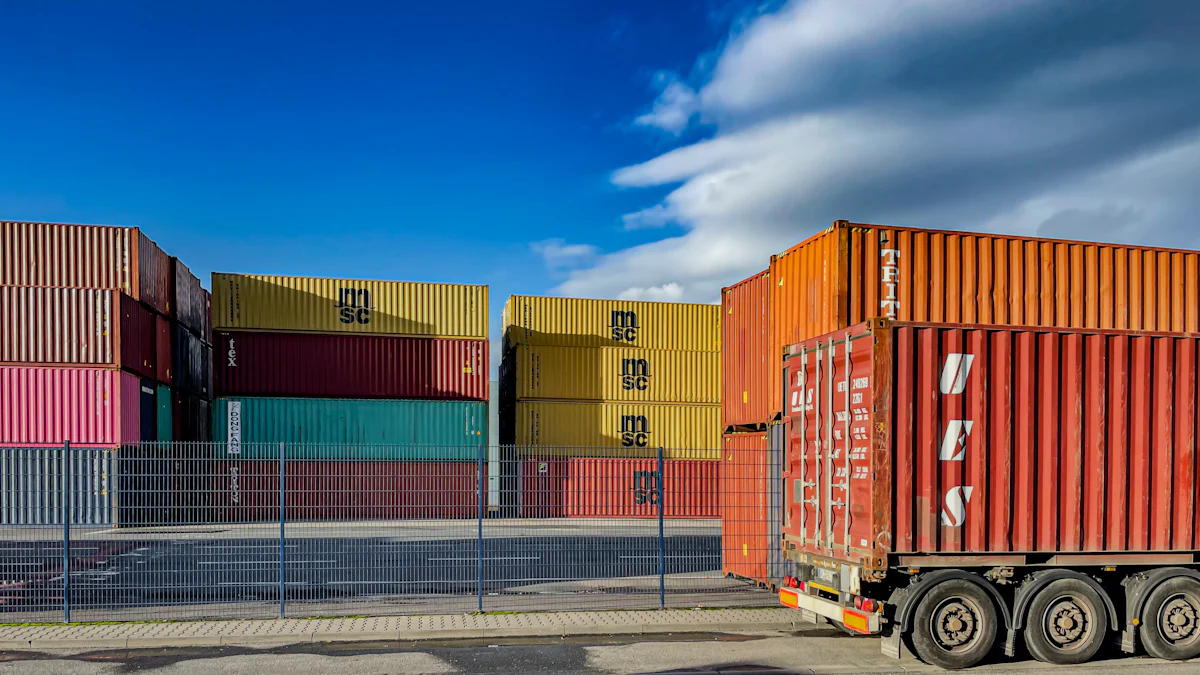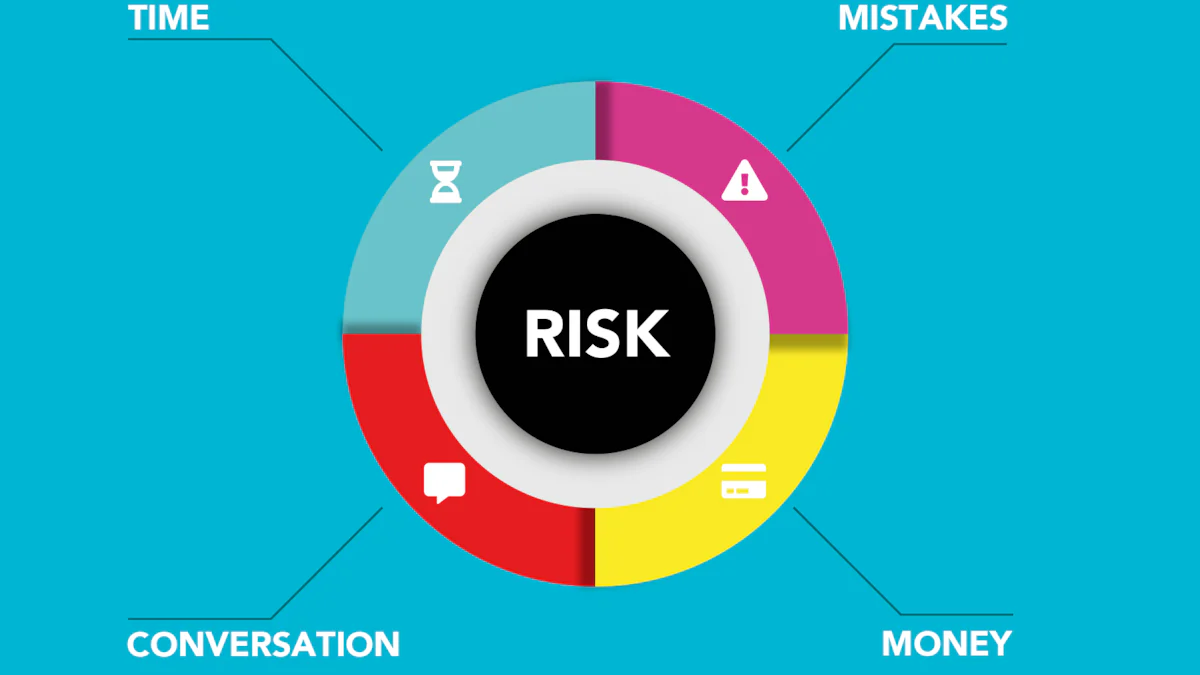Top 10 Supply Chain Risks Companies Must Address in 2025

Supply chain risks in 2025 present unprecedented challenges for businesses. CEOs now rank supply chain as one of the top three risks to operations. Geopolitical instability, inflationary pressures, and labor shortages in warehousing and manufacturing exacerbate these complexities. Cybersecurity threats, driven by advanced technologies, further disrupt supply chain management. The COVID-19 pandemic underscored how disruptions can halt production, increase costs, and jeopardize continuity. Strategic planning and risk management have become essential to navigate these uncertainties. A robust supply chain risk assessment ensures businesses remain agile and competitive in this volatile landscape.
Geopolitical Instability and Supply Chain Risk
Trade Wars and Sanctions: Navigating Global Challenges
Geopolitical tensions continue to reshape global supply chains, creating significant challenges for businesses. Trade wars, such as those between the United States and China, have introduced tariffs and trade barriers that disrupt established supply chain networks. These measures increase costs for businesses and consumers, forcing companies to reevaluate their sourcing and production strategies. For instance, higher import costs often lead to reduced production and job losses, further complicating supply chain risk management.
Conflicts like the Russia-Ukraine war and the Israel-Hamas war exacerbate these issues by destabilizing regions critical to energy and food security. Such instability impacts global inflation rates and disrupts supply routes, making it harder for businesses to maintain operational continuity. To mitigate these risks, many companies are exploring regionalization, which involves shifting operations closer to end markets. This approach reduces reliance on volatile international supply chains and enhances resilience against geopolitical disruptions.
Political Uncertainty in Key Markets: Strategies for Stability
Political uncertainty in key markets poses another layer of complexity to supply chain risks. Sudden policy changes, regulatory shifts, or leadership transitions can disrupt local infrastructure and create unforeseen challenges. Businesses operating in politically unstable regions must adopt proactive strategies to safeguard their operations.
Effective measures include conducting thorough risk analyses to understand local conditions and consulting with trusted local partners for market insights. Utilizing local banking services can also help reduce financial exposure to political risks. Additionally, purchasing political risk insurance provides a safety net for protecting assets in volatile regions. Companies that monitor global issues and adapt their strategies accordingly can better navigate these uncertainties.
By implementing these strategies, businesses can build more stable and resilient supply chains, ensuring they remain competitive in an increasingly unpredictable geopolitical landscape.
Cybersecurity Threats in Supply Chain Risk Management
Protecting Against Supply Chain Cyberattacks
Cybersecurity threats have become a critical concern in supply chain risk management. As supply chains grow more interconnected, they become increasingly vulnerable to cyberattacks. Common threats include phishing and social engineering, where deceptive emails trick employees into revealing sensitive information. Ransomware attacks encrypt critical data, demanding payment for its release. Supply chain attacks exploit vulnerabilities in third-party vendors, injecting malicious code into systems. Other threats, such as malware infections, man-in-the-middle attacks, and distributed denial-of-service (DDoS) attacks, disrupt operations and compromise data integrity.
Effective supply chain risk management requires a proactive approach to cybersecurity. By integrating these practices, businesses can safeguard their operations and maintain supply chain visibility, even in the face of evolving cyber threats.
Enhancing Digital Infrastructure and Data Security
Enhancing digital infrastructure is essential for effective supply chain risk management. Advanced technologies, such as the Eclypsium Supply Chain Security Platform, improve detection times and strengthen security postures. Collaborations like Eclypsium's partnership with Intel provide businesses with greater visibility into their supply chains, enabling them to identify and address vulnerabilities more effectively.
Organizations can also achieve regulatory compliance and reduce risks by implementing security controls for device integrity and firmware security. Investing in continuous monitoring tools ensures real-time detection of potential threats. Integrating these tools with existing systems enhances supply chain visibility and streamlines operations. Additionally, standardizing cybersecurity requirements in vendor contracts ensures alignment with organizational security goals.
A robust digital infrastructure not only mitigates risks but also supports effective supply chain risk management. By prioritizing data security, businesses can navigate challenges and maintain operational continuity in an increasingly digital landscape.
Climate Change and Natural Disasters: A Growing Supply Chain Risk

Impact of Extreme Weather Events on Logistics
Extreme weather events increasingly disrupt logistics networks, posing significant challenges for businesses. Infrastructure damage caused by flooding, hurricanes, or high winds often renders roads, bridges, and ports unusable. These disruptions delay shipping and transportation, leading to material shortages and higher costs. For example, in 2024, global supply chain disruptions due to extreme weather events cost companies over $100 billion, underscoring the economic impact of these disasters.
Rising temperatures and unpredictable weather patterns further complicate supply chain operations. Frequent natural disasters, occurring approximately every three weeks, strain transportation routes and damage critical infrastructure. These disruptions reduce supply chain reliability and increase operational risks. Companies must address these challenges to maintain continuity and minimize financial losses.
Building Resilient and Sustainable Supply Chains
Businesses must adopt proactive strategies to build resilient and sustainable supply chains. Key components include risk management, strong supplier relationships, and transparency. Predictive analytics and digital transformation play a crucial role in identifying vulnerabilities and enhancing operational efficiency. Sustainability initiatives, such as reducing carbon footprints and investing in green technologies, also strengthen supply chains against future disruptions.
Collaborative efforts between companies and suppliers foster innovation and resilience. Joint development projects and technology sharing enhance interdependence, enabling businesses to adapt to market fluctuations. Investing in resilient infrastructure, such as weather-resistant facilities and advanced transportation systems, mitigates the impact of natural disasters. By integrating these strategies, businesses can navigate supply chain risks effectively and ensure long-term stability.
Collaborative initiatives that go beyond transactional interactions drive innovation and resilience, helping businesses withstand the ongoing challenges posed by climate change.
As climate change continues to affect supply chains, companies must prioritize sustainability and resilience to remain competitive in a volatile environment.
Global Economic Volatility and Supply Chain Risks
Managing Inflation and Currency Fluctuations
Global economic volatility presents significant challenges for businesses, particularly in managing inflation and currency fluctuations. Rising inflation increases production costs, while currency instability disrupts pricing strategies and financial planning. These factors create uncertainty, making supply chain risk mitigation essential for maintaining continuity.
Companies can adopt several risk management strategies to address these challenges. Utilizing planning software to model stress scenarios helps businesses prepare for inflationary pressures and demand surges. Diversifying manufacturing locations through a "China plus one" strategy reduces reliance on a single region, mitigating high transportation costs and supply shortages. Additionally, implementing "local for local" strategies allows businesses to operate closer to customers, minimizing transportation expenses and exposure to currency fluctuations.
Flexibility remains crucial in managing inflation. Businesses should stress test their supply chains to identify vulnerabilities and develop backup plans. Relocating production closer to end markets and examining supplier resilience ensures operations remain stable despite economic uncertainties. By adopting these strategies, companies can effectively navigate the complexities of global economic volatility.
Financial Risk Mitigation Strategies for 2025
Effective financial risk management strategies are vital for addressing supply chain risks in 2025. Advanced analytics and AI play a pivotal role in predicting disruptions and recommending mitigation measures. These technologies enhance decision-making by providing real-time insights into potential risks.
Improving supply chain visibility through IoT devices and collaboration with partners strengthens risk management strategies. Structured risk assessment frameworks help businesses categorize and regularly update risks, ensuring preparedness for unforeseen events. Diversifying supplier networks further enhances resilience, reducing dependency on single sources and mitigating financial exposure.
Fostering a culture of risk awareness among employees is equally important. Training programs and open communication encourage proactive identification and resolution of risks. By integrating these strategies, businesses can build robust supply chains capable of withstanding economic volatility.
Companies that prioritize supply chain risk mitigation through advanced technologies and diversified networks will maintain a competitive edge in 2025.
Labor Shortages and Workforce Challenges in Supply Chains
Addressing Talent Gaps in Logistics and Manufacturing
Labor shortages in supply chains have become a pressing issue, driven by demographic shifts and evolving workforce expectations. As Baby Boomers and Generation X retire, Millennials and Gen Z dominate the talent pool. However, this generational shift has created a mismatch in industry perception and trust. Younger candidates often lack the supervisory experience needed for managerial roles. Additionally, the demand for "new collar" workers—those with a mix of technical, physical, and soft skills—has surged due to advancements in supply chain technology. This skills gap could leave 2.1 million critical jobs unfilled by 2030.
The COVID-19 pandemic has further highlighted these challenges. Job seekers now prioritize mental health and work-life balance, compelling employers to adapt their company cultures. Political restraints on immigration and climate change have also exacerbated global shortages, reducing worker availability and productivity. To address these issues, companies must enhance hiring practices by clearly defining ideal candidate profiles. Upskilling existing employees through targeted training programs can bridge the skills gap. Partnering with third-party logistics providers offers access to specialized expertise, enabling businesses to maintain operational efficiency.
The retirement of Baby Boomers poses another challenge, as a quarter of manufacturing workers are over 55. This demographic shift reduces institutional knowledge and productivity, making workforce development a critical focus for supply chain resilience.
Leveraging Automation and Workforce Development
Automation plays a pivotal role in overcoming workforce challenges. Autonomous Mobile Robots (AMRs) have revolutionized warehouse operations by streamlining workflows. For instance, one warehouse employing visually impaired workers reported a 2.5-fold increase in picking productivity after implementing AMRs. Automation reduces time spent on repetitive tasks, such as traveling to item locations, which accounts for 10% of operational time. By eliminating inefficiencies, businesses can optimize labor utilization and address shortages effectively.
Supply Chain Disruptions from Pandemics

Strengthening Health Crisis Response Plans
Strengthening health crisis response plans requires a focus on flexibility and agility. Companies must adopt processes and technologies that allow supply chains to expand or contract as needed. Prioritizing effectiveness over efficiency ensures the availability of critical supplies during emergencies. Agility in operations enables quick responses to sudden changes in demand or supply, reducing the impact of disruptions.
By integrating these strategies, companies can build resilient supply chains capable of withstanding health crises and other unforeseen challenges.
Regulatory and Compliance Risks in Supply Chain Management
Adapting to Evolving ESG and Trade Regulations
Regulatory challenges in supply chain risk management are intensifying as governments worldwide introduce stricter requirements. Companies face uncertainty about global trade agreements, with some jurisdictions rolling back regulations while others, like France, strengthen them through laws such as the "duty of care." Stricter environmental standards, enhanced labor practices, and increased product safety regulations demand greater visibility and compliance across supply chains.
Real-time data and analytics play a critical role in evaluating ESG performance. These tools provide actionable insights, allowing companies to meet sustainability goals while maintaining operational efficiency. By prioritizing compliance and leveraging advanced technologies, businesses can navigate regulatory challenges and strengthen their supply chain risk management strategies.
Ensuring Ethical Sourcing and Compliance
Ethical sourcing has become a cornerstone of supply chain management. Companies must select suppliers whose sustainability commitments align with their values. Criteria reflecting ESG objectives, such as renewable energy use and carbon footprint reduction, guide this selection process. Collaborative efforts with suppliers foster partnerships aimed at achieving shared sustainability goals.
Establishing robust compliance frameworks further enhances ethical sourcing. These frameworks ensure adherence to regulations and promote accountability across supply chains. By integrating these practices, businesses can address supply chain risk effectively while meeting regulatory requirements and ESG objectives.
Companies that embrace ethical sourcing and compliance not only mitigate risks but also build trust with stakeholders, ensuring long-term success in a competitive market.
Supplier Reliability and Dependency: A Critical Supply Chain Risk
Overcoming Over-Reliance on Single Suppliers
Relying heavily on a single supplier introduces significant risks to supply chain operations. Natural disasters or political instability can disrupt production, leading to supply shortages. For instance, a critical component sourced from a single factory can halt the entire supply chain if that facility encounters issues. This lack of redundancy leaves businesses vulnerable to unexpected challenges.
Over-reliance also limits operational resilience. Approximately 85% of disruptions occur in the lower tiers of the supply chain, where visibility is often minimal. Companies must address this vulnerability by implementing strategies that reduce dependency on single suppliers. Conducting thorough risk assessments and establishing contingency plans can mitigate potential disruptions. Businesses should also invest in technologies that enhance supply chain visibility, enabling them to identify and address vulnerabilities proactively.
Diversifying Supplier Networks for Resilience
Diversifying suppliers is essential for building a resilient and agile supply chain. Sourcing from multiple suppliers reduces dependency on any single entity, minimizing the impact of disruptions caused by geopolitical or economic factors. A diverse supplier base also fosters innovation and cost efficiency, providing businesses with a competitive edge.
Maintaining a diverse supply chain demands agility and responsiveness. Companies must establish strong relationships with suppliers across various regions to ensure adaptability during disruptions. By diversifying suppliers, businesses can navigate supply chain risks effectively and sustain long-term growth.
A well-diversified supplier network not only mitigates risks but also strengthens a company’s ability to innovate and adapt in an unpredictable global market.
Technological Disruptions in Supply Chain Risk Management
Challenges of Adopting Emerging Technologies
Adopting emerging technologies in supply chain management presents significant challenges for businesses. Integration complexity often ranks as the most pressing issue, with 30% of companies struggling to align new systems with existing infrastructure. Many organizations also find that the technology fails to meet expectations, accounting for 28% of adoption difficulties. People capabilities, such as a lack of skilled personnel, contribute to 27% of these challenges. Data-related issues, including poor data quality and insufficient analytics, affect 26% of companies. Vendor capabilities, such as limited technical support or expertise, impact 25% of businesses attempting to implement new solutions.
These challenges highlight the need for a strategic approach to technology adoption. Companies must conduct thorough evaluations of their current systems and workforce capabilities before integrating new tools. Training programs can address skill gaps, while partnerships with reliable vendors ensure access to technical expertise. By addressing these obstacles proactively, businesses can enhance their supply chain risk management strategies and maximize the benefits of emerging technologies.
Integrating Digital Tools for Seamless Operations
Integrating digital tools is essential for achieving seamless operations in supply chain management. Advanced platforms, such as JUSDA's Supply Chain Management Collaboration Platform, enable real-time collaboration and visibility across the supply chain. These tools streamline processes like demand forecasting, inventory management, and transportation coordination, reducing inefficiencies and enhancing decision-making.
To integrate digital tools effectively, businesses should prioritize compatibility with existing systems and invest in employee training. Collaboration with technology providers ensures smooth implementation and ongoing support. By leveraging digital tools, companies can build resilient supply chains capable of adapting to an ever-changing global landscape.
Consumer Demand Volatility and Supply Chain Risks
Managing Fluctuations in Consumer Preferences
To manage these fluctuations effectively, businesses must adopt proactive strategies. Robust data analytics tools help track sales trends and forecast demand accurately. Just-In-Time inventory practices minimize excess stock and reduce holding costs. Strong supplier relationships enhance flexibility, while inventory segmentation addresses demand variability. Leveraging technology, such as inventory management software, automates tracking and reordering processes. Regular customer feedback collection anticipates shifts in preferences, and agile supply chains adapt quickly to changes. A clear returns management process ensures accurate stock counts and minimizes losses.
By implementing these measures, companies can mitigate supply chain risk and maintain operational stability despite volatile consumer demand.
Enhancing Demand Forecasting and Agility with JUSDA Solutions
Accurate demand forecasting is essential for navigating consumer demand volatility. Businesses can predict fluctuations by analyzing historical sales data, identifying trends, and understanding seasonality. JUSDA's Supply Chain Management Collaboration Platform offers advanced tools to enhance forecasting accuracy and supply chain agility. The platform integrates real-time data and predictive analytics, enabling businesses to maintain optimal stock levels and plan for promotions effectively.
JUSDA's solutions also facilitate collaboration with supply chain partners, ensuring seamless information sharing. Features like demand forecasting coordination and inventory visibility empower businesses to adapt to market changes swiftly. By utilizing advanced analytics, companies can regularly update forecasts and respond proactively to emerging trends.
JUSDA's platform exemplifies how technology can transform supply chain operations. Its capabilities in demand forecasting, inventory management, and transport coordination reduce inefficiencies and enhance decision-making. Businesses leveraging these tools can build resilient supply chains that withstand demand volatility and maintain a competitive edge.

JUSDA Solutions
To provide you with professional solutions and quotations.
Companies that prioritize forecasting and agility through innovative solutions like JUSDA's platform can navigate consumer demand volatility with confidence
The interconnected nature of supply chain risks in 2025 demands a proactive and strategic approach. Companies must prioritize agility and resilience to adapt to disruptions effectively. Real-time visibility and traceability enhance transparency, enabling businesses to manage risks and maintain continuity. Digital integration, powered by technologies like AI and cloud computing, strengthens operational efficiency and fosters resilience. Strategic sourcing and supplier diversification mitigate vulnerabilities, while workforce upskilling ensures adaptability to automation.
JUSDA's Supply Chain Management Collaboration Platform offers innovative tools to address these challenges. Its advanced features, such as demand forecasting and real-time tracking, empower businesses to build resilient supply chains. By leveraging JUSDA's solutions, companies can navigate supply chain risks confidently and secure long-term success.
See Also
Address Supply Chain Risks To Safeguard Your Business
Understanding Risks: Protecting Your Supply Chain Effectively
Embracing Sustainability To Mitigate Supply Chain Risks
